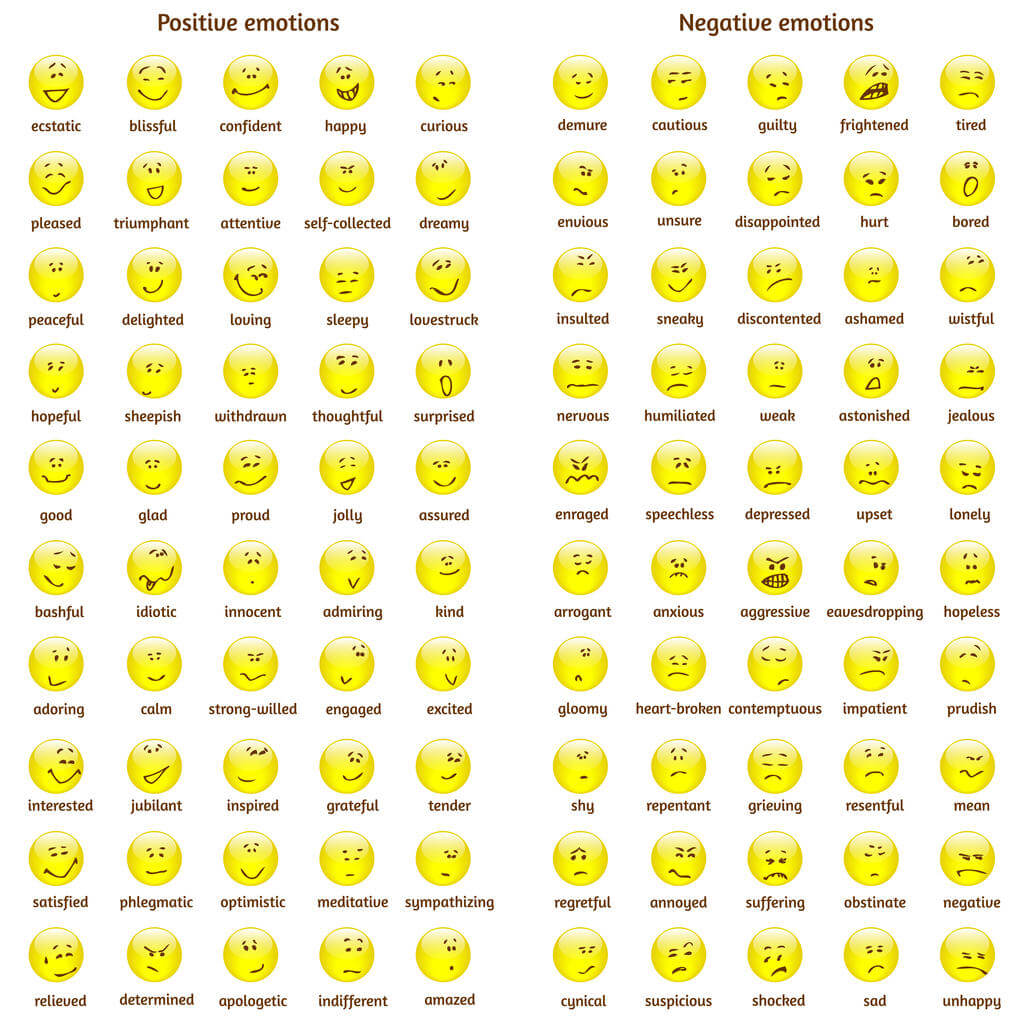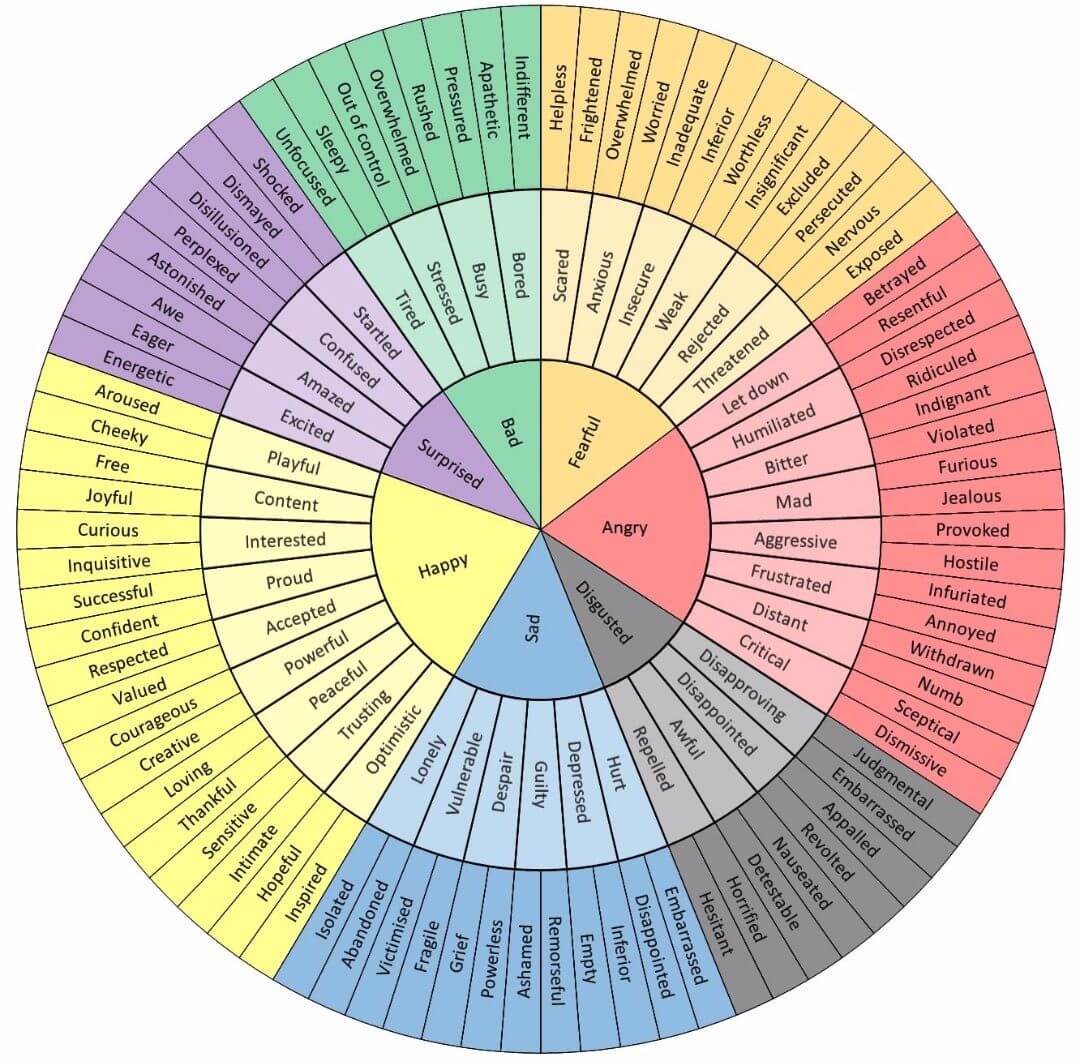What Are Positive Emotions?
Positive emotions are emotions that we typically find pleasurable to experience. The Oxford Handbook of Positive Psychology defines them as “pleasant or desirable situational responses… distinct from pleasurable sensation and undifferentiated positive affect” (Cohn & Fredrickson, 2009).
Basically, this definition is stating that positive emotions are pleasant responses to our environment (or our own internal dialogue) that are more complex and targeted than simple sensations.
What Are Negative Emotions?
On the other hand, negative emotions are those that we typically do not find pleasurable to experience. Negative emotions can be defined as “as an unpleasant or unhappy emotion which is evoked in individuals to express a negative effect towards an event or person” (Pam, 2013).
If an emotion discourages and drags you down, then it’s most likely a negative emotion.
17 Examples: A List of Positive and Negative Emotions
Examples of positive and negative emotions will vary based on who you ask; even the definition of an emotion can vary based on who answers the question. However you define emotion, discerning between the two is an intuitive process—we seem to “just know” which emotions are positive and which are negative.
Some common positive emotions include:
Love
Joy
Satisfaction
Contentment
Interest
Amusement
Happiness
Serenity
Awe
A few of the most commonly felt negative emotions are:
Fear
Anger
Disgust
Sadness
Rage
Loneliness
Melancholy
Annoyance
Do We Need Both?
Look back over the list of sample negative emotions. Do you want to feel any of those emotions? You probably don’t, and it’s no wonder! It doesn’t feel good to experience any of those emotions.
Now, refer to the list of sample positive emotions. Have you ever felt one of these emotions and thought to yourself, “I wish I wasn’t experiencing this emotion?” Although you may have experienced this once or twice—generally at a time when we think we shouldn’t feel positive emotions—it’s easy to see that this list is full of pleasurable emotions that people tend to seek out. We know that we need positive emotions to function effectively, grow, and thrive.
So if it’s basically universally unpleasant for us to experience negative emotions and universally pleasant and desirable to experience positive emotions, do we actually need the negative ones at all?
As it turns out, yes!
Are Negative Emotions Necessary?
Although they are not pleasant to experience, negative emotions really are necessary for a healthy life. This is true for two big reasons:
Negative emotions give us a counterpoint to positive emotions; without the negative, would the positive emotions still feel as good?
Negative emotions serve evolutionary purposes, encouraging us to act in ways that boost our chances of survival and help us grow and develop as people.
As Tracy Kennedy from Lifehack.org points out, there is a good reason for each of the basic emotions, both positive and negative:
Anger: to fight against problems
Fear: to protect us from danger
Anticipation: to look forward and plan
Surprise: to focus on new situations
Joy: to remind us what’s important
Sadness: to connect us with those we love
Trust: to connect with people who help
Disgust: to reject what is unhealthy (2018)
Without fear, would you be here today? Or would you have engaged in some risky practices, putting yourself in unnecessary danger? Without disgust, would you have been able to refrain from putting any of the many, many harmful substances that you had access to as a toddler?
As unpleasant as they may be, it can’t be denied that negative emotions serve important purposes in our lives.
Is it True that an Individual Will Only Feel Stress in Negative Situations?
Although you may think of stress as a solidly negative emotion or response to a situation, it’s actually quite common for people to experience stress in neutral and positive situations as well.
In fact, many experiences commonly thought of as positive can contribute huge amounts of stress to our lives.
Here are just a few examples of positive experiences that can bring us stress:
Planning for an upcoming wedding
Preparing to move to somewhere you are excited to live
The holidays—especially with family!
Having a baby
Starting an exciting new job
It’s perfectly natural to feel stress in all of these situations, even though you would probably classify them as happy and positive. It’s yet another example of the interplay between positive and negative that gives our lives balance.
Positive vs. Negative Emotions: A Look at the Differences
As we now know, positive and negative emotions are both vital for a healthy, well-rounded life. Let’s take a look at how emotions in both categories impact us.
How Do They Affect the Brain?
Positive and negative emotions both have important roles to play when it comes to the brain, but they are generally separate roles.
For example, positive emotions have been shown to impact the brain in the following ways:
They can increase our performance on a cognitive task by lifting our spirits without distracting us like negative emotions do (Iordan & Dolcos, 2017).
Positive emotions can trigger the reward pathways in the brain, contributing to lower levels of a stress hormone and greater well-being (Ricard, Lutz, & Davidson, 2014).
Positive emotions may help us broaden our horizons and widen our brain’s scope of focus (Fredrickson, 2001).
Meanwhile, negative emotions are known to affect the brain in the following ways:
Facilitating emotional conflict processing, helping us to make sense of incongruent or conflicting emotional information; in other words, negative emotions can help us figure tough emotional problems (Zinchenko et al., 2015).
Facilitating cognitive conflict processing, aiding us in comprehending incongruent or conflicting cognitive information; in other words, negative emotions can also help us make sense when we receive confusing signals (Kanske & Kotz, 2010; 2011).
Reducing the experience of empathy, which can help protect us from getting too involved with others and stay focused on our goals (Qiao-Tasserit, Corradi-Dell’Acqua, & Vuilleumier, 2017).
Both have impactful roles to play in our brain, and these roles are complementary rather than competitive.
The Role of Both in Positive Psychology
Given the impact of positive and negative emotions on our thoughts and behaviors, it’s easy to see why positive psychology keeps a close eye on negative emotions in addition to the positive. As vital as it is for us to learn how to boost our positive emotions and take advantage of the opportunities they bring, it’s just as vital to learn how to adapt from negative emotions and cope with them effectively.
When we are able to accept, embrace, and exploit both our positive and our negative emotions, we give ourselves the best chance to live a balanced, meaningful life. This is why the field of positive psychology is hesitant to focus too much on positive emotions alone—it is just as important to understand how to turn negative emotions into a positive experience as it is to capitalize on our positive emotions.
How Can We Best Track Our Emotions?
Now we know about the importance of accepting and managing our emotions—both positive and negative—the next question is how we actually do this.
The first step to effectively managing our emotions is to identify, understand, and find the patterns in our emotional experiences.
Check out the examples below, or make your own if you’re feeling creative.
Positive and Negative Emoji Chart:


A Brief Look at Neutral Emotions
While positive and negative emotions have received substantial attention from researchers and psychology practitioners, there’s another category of emotions that have been all but ignored in many circles: neutral emotions.
You won’t hear much about these middle ground feelings from psychologists, but they are a much-discussed topic in some Buddhism circles. These emotions are referred to as adukkhamasukha, which can translate to “not painful not pleasant” (Anālayo, 2017). They refer to “a range in the middle part of the spectrum of felt experience… between pain and pleasure… relatively bland and neither distinctly painful nor clearly pleasant” (Anālayo, 2017).
Since neutral feelings are such a mundane topic for most of us, we rarely give them much thought; however, they may be the emotional category where we spend most of our time! Think about your day: how much of it was spent in joy and contentment? How much in anger and sadness? The answer to those questions is likely to be far less time than you had in the day. The emotions you felt the rest of the time were likely neutral.
Although neutral feelings do not have a valence—positive or negative—some say that neutral feelings can be counted as positive feelings, since they are characterized by the absence of pain and suffering.
Whatever you believe about negative emotions, keep them in mind as an important, if oft-forgotten, piece of your emotional experience.
A Take-Home Message
As always, I hope you leave this piece with a little more knowledge than when you began reading. Identifying, accepting, and managing our emotions—both positive and negative—is such an important task for living a healthy and happy life. Use what you have learned here to enhance your understanding of your own feelings and the feelings of others, and commit to greater awareness and management of your own emotional state. You won’t regret it!
What are your thoughts on the subject? Do you think negative emotions are necessary, or do you think we could do away with them without any adverse effects? What sort of balance do you aim for? Let us know in the comments section below.
Thanks for reading! https://positivepsychology.com/positive-negative-emotions/

No comments:
Post a Comment